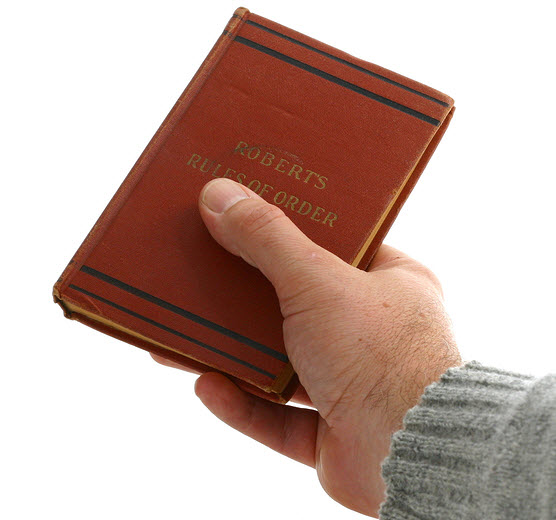Have your conference calls ever bogged down in endless discussion? Or perhaps they’ve slipped out of control due to disorderly conduct from monopolizers and interrupters. whose poor etiquette comes across as counter-productive.
You want to foster open participation while maintaining control, without being bossy. And, most importantly, you want to keep things moving along to an acceptable outcome, and to reach the goals you’ve set for the meeting.
If this sounds like your situation, you just might benefit from more orderly conference calls by sprinkling in some good old Robert’s Rules of Order. It might just keep your meetings on-point and humming along!
Here are 3 actions you could take for incorporating Robert’s Rules of Order in your conference calls:
Become familiar with the spirit and intent of the Rules
It will not be practical, in most cases, to implement Robert’s Rules of Order in a “by the letter” manner. You will need to adapt them to the various types, purposes, situations and locations of meetings you conduct. What will help is to begin with a good idea of their overall purpose and what they’re designed to do. According to this summary version, Robert’s Rules of Order are designed to provide a fair and orderly framework from which to conduct meetings that result in democratic outcomes: “Robert’s Rules provides for constructive and democratic meetings, to help, not hinder, the business of assembly.” Key guidelines to consider- The “Chair” or host of the meeting must maintain control to ensure the meeting is conducted in a fair and orderly manner
- Keep discussion focused on the subject (motion) at hand without going off-topic
- Let everyone who wants to speak on an issue have a turn before allowing a participant to speak twice
- Participants should direct their remarks to the host and keep things at a professional level
- Always be courteous and avoid personality clashes or delving into ulterior motives
Adapt some of the Rules to your situation
Once you have a good handle on the guidelines for using Robert’s Rules, you can choose some of the Rules and adapt them for your use. (You might want to print out a list of the rules from this print-friendly page.) For example, here are a few that may lend themselves nicely to a modern conferencing and meeting situation:- “Point of privilege”: This is one of the few times someone can interrupt the speaker and is used to complain about noise or conditions hindering communication. It’s directed at the Chair or host, and it does not need to be seconded, debated or amended – the host/meeting leader decides what action, if any is to be done.
- “Point of information”: Another of Robert’s Rules that can interrupt the speaker. It’s used to request more information or ask a question of the speaker. We can imagine how it may be used to probe further and gain a better understanding of a participant’s viewpoint on an issue being discussed.
- “I move that we table it”: This can be used (without interrupting a speaker) to suspend further discussion and essentially table it to a future meeting. It allows you to then move on to the next agenda item or issue. It does need a “Second”, it’s not debatable, but does require a majority vote to pass. This is a great Rule to put a pause on endless discussion that seems to be going nowhere, in a “fair and orderly” manner.
Keep learning, adopting, experimenting
The key is to get started and see how the guidelines and rules you adopt work and make for better, faster, and of course, more participative, fair and orderly meetings. Then expand your knowledge and implementation of Robert’s Rules of Order into your meeting routine. For example, the cheat sheet mentioned above has a step-by-step procedure for handling a main motion (essentially a new idea or action for the group to consider). Bookmark this page and refer to it in the future and the following references for further learning:- Robert’s Rules of Order (“Official” Website): Has lots of information on the history, updates to and recommendations on how to adopt them.
- Robert’s Rules of Order on Wikipedia
- 11th Edition of Robert’s Rules of Order on Amazon
- How to Avoid the 5 Biggest Robert’s Rules of Order Mistakes (3 min. video by Susan Leahy)
- Robert’s Rules of Order Made Simple (training website)
Can the Robert’s Rules of Order be useful to your conference calls? One would have to believe they can. Afterall, they’ve been around for over 138 years since being first published in 1876 by U.S. Army Colonel Henry Martyn Robert as the Pocket Manual of Rules of Order for Deliberative Assemblies.


![How to Assess Department & New Business Opportunities [Webinar]](https://blog.adigo.com/wp-content/uploads/2021/08/adigo-free-webinar-1.png)

0 Comments